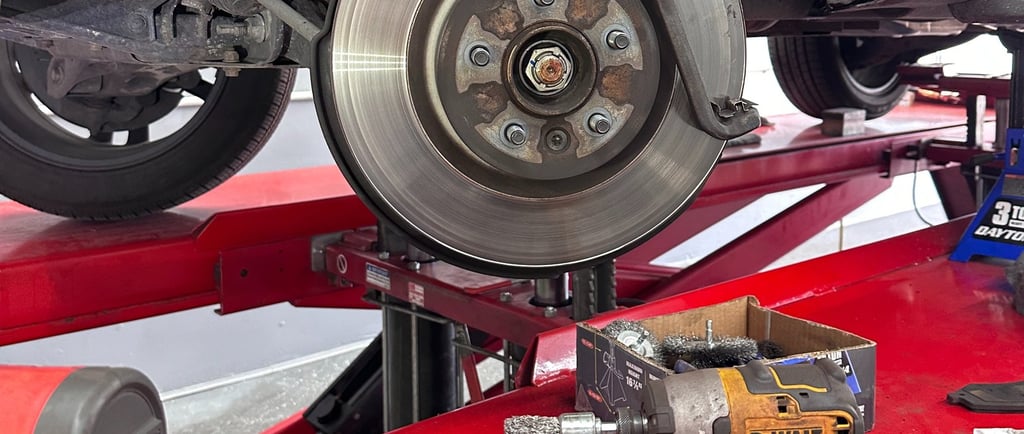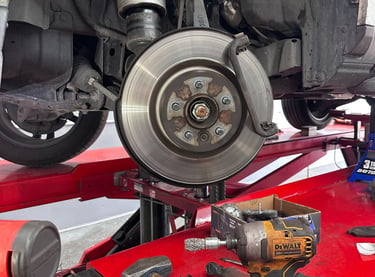Exploring the Various Types of Brake Pads: Which One is Right for You?
Blog | Learn how to choose the best brake pads for your driving style in Northridge, CA. A mechanic with 15+ years of experience breaks down the pros and cons of organic, semi-metallic, low-metallic, and ceramic pads—with real-world tips, examples, and local advice
George D.
7/6/20243 min read


Brake Pads in Northridge: A Mechanic's Guide to Picking the Right Type for Your Car
🛠 Need brake pads in Northridge? At George’s Alignment & Brake Service, we’ll recommend the right pads for how you actually drive — and get you safely back on the road the same day.
📞 Call us at (818) 855-6545
Real Talk from a Northridge Mechanic
Twenty years of turning wrenches in Northridge has taught me one thing: most drivers only think about their brakes when they start making that awful grinding sound. By then, what should’ve been a simple brake pad replacement becomes a much more expensive repair.
Just last week, a customer drove in from Chatsworth with a 2019 Honda Accord, complaining about "weird noises when I stop." Turns out, she’d been driving on metal-to-metal contact for three weeks. Instead of a $199 brake pad job, she ended up paying $370+ for new rotors and labor.
That’s why I wrote this guide — not to sell you something, but to help you make the right call before it gets costly.
How Brake Pads Work (Without the Engineering Degree)
Think of it like squeezing a spinning bike wheel with your hands. Brake pads clamp down on spinning metal discs (rotors) attached to your wheels, creating friction that slows the car down.
But not all brake pads are the same. The material they’re made from changes everything — noise levels, stopping power, heat tolerance, and how long they last.
The 4 Types of Brake Pads – Straight from the Shop Floor
1. Organic Brake Pads: Budget-Friendly and Quiet
Made from glass fibers, rubber, and resins. These are gentle on rotors and whisper-quiet.
✅ Pros:
Least expensive
Very quiet
Easy on brake rotors
❌ Cons:
Wear out quickly
Overheat in stop-and-go traffic
Poor performance on hills or mountain roads
📌 Best for: Light daily driving in flat areas like city errands around Reseda or Van Nuys.
2. Semi-Metallic Brake Pads: Tough and Reliable
Made with 30–65% metal (steel, copper, etc.). These are the workhorses.
✅ Pros:
Excellent stopping power
Handles heat like a champ
Lasts a long time
❌ Cons:
Louder (especially when cold)
More brake dust
Harder on rotors
📌 Best for: SUVs, trucks, drivers on the 405 or 118 freeway, or those who head to the mountains often.
3. Low-Metallic NAO: The Balanced Option
Organic base with 10–30% metal content. My most common recommendation.
✅ Pros:
Good braking power
Decent heat resistance
Quieter than full-metal pads
❌ Cons:
Can squeak at low speeds
More dust than ceramics
📌 Best for: Most sedans and crossovers in Northridge, Chatsworth, and Panorama City.
4. Ceramic Brake Pads: Clean and Quiet Premium Choice
Made from ceramic fibers and fillers. These are smooth, durable, and clean.
✅ Pros:
Super quiet
Low brake dust = clean wheels
Very long lifespan
Great for stop-and-go driving
❌ Cons:
Higher price tag
Not ideal for heavy towing or track driving
📌 Best for: EVs, luxury cars, and anyone commuting across surface streets in the Valley.
So, What Works Best in Northridge?
🛞 Commuting across the Valley? → Ceramic pads are a smart long-term investment.
⛰ Frequent freeway braking or canyon runs? → Semi-metallic for heat control.
🚙 Mix of city + mountain driving? → Go with Low-metallic NAO for versatility.
💸 On a tight budget? → Organic pads are fine — just plan for more frequent replacements.
How Long Does a Brake Job Take?
Warning Signs That Can’t Wait
These red flags mean you need to stop driving and get inspected ASAP:
🚨 Grinding metal sounds – pads are gone, rotors are being destroyed
🚨 Brake pedal feels soft – may be fluid leak or master cylinder failure
🚨 Car pulls during braking – uneven wear or stuck caliper
🚨 Burning smell after stops – overheated pads or stuck brakes
🚨 Brake pedal vibrates when stopping – likely warped rotors or uneven pad deposits
Real Work, Real Results
Shop Tips You Can Use Today
✔ New pads? Go easy for the first 200 miles
✔ Squealing after rain? Normal — moisture on rotors
✔ “Spongy” pedal? You probably need brake fluid service
✔ Brake fluid dark? Time to flush it
Frequently Asked Brake Pad Questions (Northridge Edition)
Q: How long do brake pads last around here?
A: Typically 25k–60k miles. Stop-and-go traffic, heat, and hills can shorten that.
Q: Can I just replace the front pads?
A: Yes — if rear pads are still in good shape. We always inspect both.
Q: Do I need ceramic brake pads for an EV?
A: Not necessarily, but many EV owners love the quiet, clean feel of ceramics.
Final Thoughts from Under the Hood
The best brake pads aren’t the ones with the flashiest packaging. They’re the ones matched to how you actually drive.
At George’s Alignment & Brake Service, we’ll help you pick what works best for your car and lifestyle — not just whatever’s on the shelf.
📍 Visit us in Northridge
📞 Call (818) 855-6545 to schedule or ask questions
George D.
Related Services




George's Alignment & Brake Service
Contacts:
Tel: +1 818 855 6545
Operation hours:
Mon-Fri: 10am - 5pm Sat: 9am - 5 pm
Service areas:
Calabasas Canoga Park Chatsworth Encino Granada Hills Hidden Hills Lake Balboa Northridge
Porter Ranch Reseda Sherwood Forest Tarzana Van Nuys West Hills Winnetka Woodland Hills
